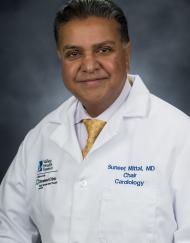Read important information about Valley's continued commitment to serving our patients and respecting their privacy, regardless of immigration status.
Read MoreHis Bundle Corrective Pacing in Heart Failure (HIS-CRT)
Objective
The objective of this study is to prospectively evaluate the efficacy and mechanism of benefit of His-bundle pacing enhanced cardiac resynchronization therapy (His-CRT) vs. cardiac resynchronization therapy (BIV-CRT) in patients with Right Bundle Branch Block (RBBB) Electrocardiogram (ECG) Pattern by assessing the improvement in left ventricular ejection fraction (LVEF) in the His-CRT vs. BIV-CRT arm at 6 months, and by evaluating changes in ECG biomarkers, NT-pro-brain natriuretic peptide (NT-proBNP) levels, and echocardiography biomarkers (left ventricular volumes, strain contractility, and dyssynchrony), as well as temporal changes in functional status and quality of life in the His-CRT vs. BIV-CRT arm at 6, 12, and 24 months.
Study Arms
- Active Comparator: HIS-CRT implantation
- Active Comparator: BIV-CRT Implantation
Eligibility
- Age 18 years or older (no upper age limit)
- Optimal medical therapy for heart failure by current guidelines
- Class IIa or IIb guideline-based indication for CRT-D implant in RBBB patients, including one of the following:
- New York Heart Association (NYHA) class II HF symptoms, LVEF ≤ 30% and QRS≥ 150 ms (IIb); OR
- NYHA class III-IV a HF, LVEF ≤ 35%, and QRS duration ≥ 150 ms (IIa); OR
- NYHA class III-IV a HF, LVEF ≤ 35%, and QRS duration 120-149 ms (IIb)
NCT ID
NCT05265520


